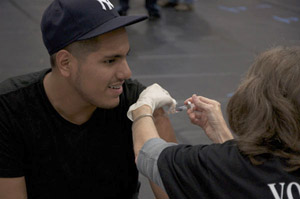University of Maryland Hosts Mass Vaccination Against Seasonal Flu
By Kelly Brooks
Maryland Newsline
Friday, Oct. 16, 2009
COLLEGE PARK, Md. - University of Maryland junior Sam Harris caught it last year and didn't want to miss classes again this year. Sophomore Bernard Wong doesn’t want to be sick when he travels to China this winter. Junior Hermela Welday's friend asked for company.
An array of reasons motivated an estimated 930 students, faculty and staff to brave the rain Thursday for a mass seasonal flu vaccination at Ritchie Coliseum, in a drill designed to test the university's emergency preparedness, officials said.
It was the first mass vaccination in the school’s history, officials said.
The model could be used to distribute the H1N1 vaccine, and on a broader scale, help the university respond to public health emergencies, university spokesperson Beth Cavanaugh said.
Ninety volunteers and university staff navigated shot-seekers through eight stations, from registration to inoculation, said Kelly Kesler, assistant director of health promotion for the University Health Center.
Many participants said they were pleased with the process, and not just because of the free shots.
A friend reminded Harris about the clinic, he said. "I ended up here, and a minute later, I'm leaving," he said. "I was expecting to be waiting in line, and I was in and out."
Jeffrey Herrmann, associate professor in the university's A. James Clark School of Engineering, created a mathematical model to see if the school had enough staffing and to estimate the capacity and congestion at the clinic. He said the drill went well.
Audio:
Jeffrey Herrmann, associate professor in the university's A. James Clark School of Engineering, explains his mathematical model.
|
At one point it took just six minutes for participants to cycle through the clinic, Herrmann said.
"Obviously, they've proven that they can give out a large number of vaccinations very quickly," he said.
Don Milton, university School of Public Health professor and director of the Maryland Institute for Applied Environmental health, agreed the clinic ran smoothly. "Perhaps more smoothly than it should, because it was raining, and not enough people came," he said.
Clinic operators distributed less than half the available 2,000 free doses.
Hopefully rain will not "dampen people's ardor" if the university holds a similar clinic for the H1N1 vaccine, said Milton, a shot recipient Thursday.
Kesler said a similar exercise for H1N1 is possible, but it depends on how much vaccine the university receives, and when it comes in.
"We actually should be getting it at any point in time, but right now we really don’t know what kind of quantity we'll get." |

